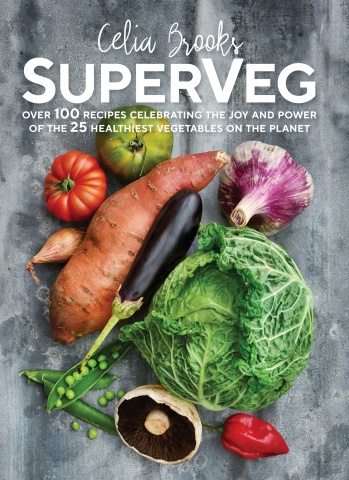Veggin’ Out with SuperVeg – Apparently, it is now National Veggie Month, so it is highly appropriate that I share with you a fabulous cookbook that – as someone who loves veg – is right up my street. It is SuperVeg by Celia Brooks (Murdoch Books, £16.99). Photography by Jean Cazals.
Moving to London from Colorado, Celia forged a career as a chef, food writer and businesswoman. She founded ‘Gastrotours’, which provides unique food experiences in London. SuperVeg is in fact her ninth book (I’ll be checking out the others now as well). You can meet her in person at the Surrey Food Festival in Richmond next month, where she will be doing a cookery demonstration.
The book is divided into three sections (Roots & Bulbs, Shoots & Leaves, and Veggie Fruits). Celia has carefully selected 25 vegetables that she heralds as ‘heroes’, not only for nutritional benefits but the simple joy of cooking them (and resulting in delicious flavours).
Recipes are coded with info such as a low-cal, good source of protein, gluten/dairy free and the book provides a wealth of information for anyone looking to incorporate more veg, or switch to a vegetarian diet.
Here is a recipe for Salt-Baked Celeriac that really enticed me…
serves 6 | prep 25 mins | cook 1 hour + cooling | low calorie | dairy free | vegan
“This has been trending on London restaurant menus for a while now, and I thought it was just a gimmicky flash in the pan until I tried it at home. I thought, well, why go to all the trouble of making a throw-away dough to bake celeriac in if it doesn’t really improve the vegetable? I guess I tried eating it at the wrong restaurants because once I did it myself, it was a totally worthwhile effort. The salt dough only takes a few minutes to throw together and what you end up with is a transformation to a whole new level of sublime – an uberceleriac.
Once baked, you have quite a large quantity of ready-to-eat celeriac, which keeps well – up to 5 days in the fridge. It can be sliced into thin or thick-ish steak-like slabs (and fried if desired, though not essential – reheating in the oven or microwave is fine too) and served as a base for a topping such as a poached egg, sautéed mushrooms or legumes. Think of it as a substitute for grains or potatoes. It can also be cut in wedges or chunks, mashed or shredded for a variety of textures, though the slab is the easiest and most effective on the plate, in my opinion.”
1 large celeriac (approx. 750 g/1 lb 10 oz unpeeled weight) 250 g (9 oz) rock salt
500 g (1 lb 2 oz/31/3 cups) plain (all-purpose) flour
Options
Serve as a carb side dish in place of grains or potatoes.
Special equipment
Large baking tray, non-stick baking paper, rolling pin, and a skewer.
Preheat the oven to 180°C (350°F) and line a large baking tray.
Peel the celeriac using a sharp knife and cut away the roots and any muddy deposits, then rinse and pat dry.
Make the salt dough. In a large bowl, mix the salt and flour, then mix in 300 ml
(101/2 fl oz) water using a wooden spoon. Get your hands in and start kneading against the side of the bowl until it draws together into a hard dough. (Add a little more flour if it is sticky.)
Place a large sheet of baking paper on your work surface and pop the dough on it, then place another sheet on top and press the dough down. Roll out the dough between the sheets into a circle with a thickness of about 5 mm (1/4 inch).
Place the celeriac directly on the dough in the middle and wrap the dough around it, completely enclosing it and making sure there are no holes.
Transfer to the baking tray and bake for 1 hour, or until the celeriac offers no resistance when pierced through to the middle with a skewer.
Allow cooling completely. Remove the crust and discard it. The celeriac is now ready to be sliced and fried or reheated to your liking (see suggestions above).
The Seasoned Gastronome
Twickenham Tribune


